Introducing the Aerostich Transit 3 suit
Surely there are few motorcyclists in 2022 still unfamiliar with Minnesota-based Aerostich, and fewer still among BMW riders. The Roadcrafter suit, upon which the company began building its sterling reputation nearly four decades ago, may be the most recognizable piece of riding kit in existence. Its ballistic nylon/GORE-TEX™ construction was an outlandish innovation when motorcycling garments had always been synonymous with cowhide, or occasionally waxed cotton, and it served as the benchmark for virtually any and all textile gear developed afterward.
Circa 2008, with the introduction of their Transit leather rider-wear, Aerostich came full-circle back to the material they’d originally left behind—but they returned with their usual revolutionary flair. The first two generations of Transits used Pro Shell, a special leather backed with GORE-TEX to make it wind- and waterproof. Supply chain problems led to the line’s discontinuation in 2013, but Aerostich found new resources to revive it in 2019.
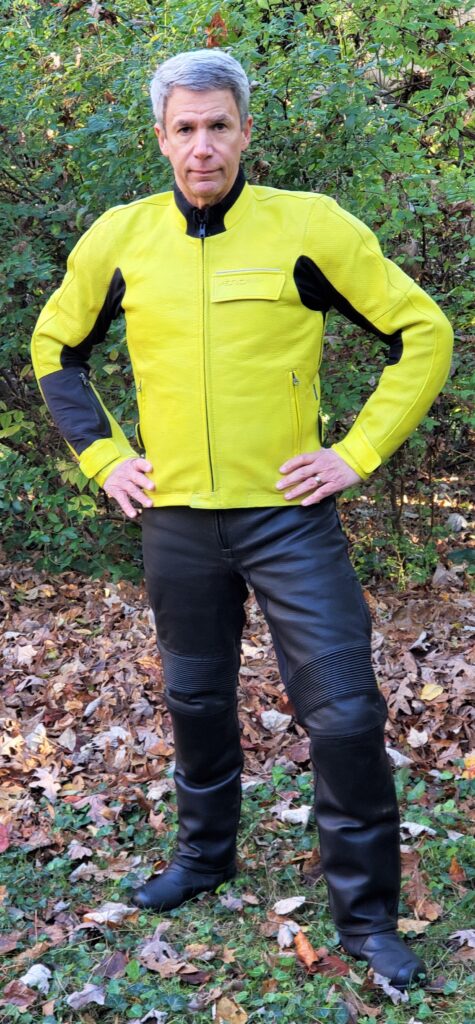 The latest (third) iteration of Transit leathers is made of Corium+ “Smart Leather.” Though it doesn’t use GORE-TEX, this material still promises the opulent feel and robust abrasion resistance of genuine top-grade leather alongside the weatherproofing of synthetics, despite also being perforated to allow moist air within the suit to escape. Such a combination of properties is typically considered the province of famous-brand linings and laminates inside crunchy Cordura shells, but Corium+ offers them to riders who prefer the classic style and soft hand of traditional leathers. Having never owned one of the earlier Transits, I can’t say how this Corium+ version compares, but to the naked eye it simply looks like a premium leather two-piece suit with a silky, airy, polyester/polyamide mesh lining and extensive built-in armor. Whatever rain-repelling superpowers it possesses are not apparent without real-world testing.
The latest (third) iteration of Transit leathers is made of Corium+ “Smart Leather.” Though it doesn’t use GORE-TEX, this material still promises the opulent feel and robust abrasion resistance of genuine top-grade leather alongside the weatherproofing of synthetics, despite also being perforated to allow moist air within the suit to escape. Such a combination of properties is typically considered the province of famous-brand linings and laminates inside crunchy Cordura shells, but Corium+ offers them to riders who prefer the classic style and soft hand of traditional leathers. Having never owned one of the earlier Transits, I can’t say how this Corium+ version compares, but to the naked eye it simply looks like a premium leather two-piece suit with a silky, airy, polyester/polyamide mesh lining and extensive built-in armor. Whatever rain-repelling superpowers it possesses are not apparent without real-world testing.
Just like the Roadcrafter lineup, The Transit 3 has been tasked by Aerostich with delivering year-round comfort and protection. Given that mission statement, I’ll be evaluating this suit over the next few seasons in a part of the country with widely varying weather conditions. The foothills and mountains of East Tennessee get quite cold, quite hot, and quite wet, with both wonderfully low and oppressively high humidity. Once I’ve sampled enough variations to address the Transit 3’s all-weather performance, a subsequent article will detail my findings. For now, I’ll just describe the suit’s features and construction. Consider this merely a detailed first impression and decide whether you want to wait on my final evaluation or get started on your own assessment sooner.
TECH
First, a little more about Corium+. In the Transit 3, this material combines a face of 1.2mm micro-perforated or 1.4mm non-perforated leather with tape-sealed seams and a breathable, one-way water-permeable membrane backing. Said membrane blocks entry of liquid water from the outside while allowing water vapor to exit from the inside. The thicker, non-perforated leather is used where maximum abrasion protection is most needed. This is a relatively thick gauge of cowhide like what you’d find in track-worthy leathers—definitely not the thin stuff of high fashion—yet it feels luxuriously refined, a trait incongruously juxtaposed with its expected durability. My old road racing suit never felt anywhere near this nice! While delivering better protection, such thickness also begs for some breaking-in. It’s been a while since I bought my last leather riding jacket, and I’d forgotten how stiff such gear can be at first. The Transit 3 is far from the stiffest I’ve sampled; while it certainly isn’t uncomfortable right out of the box, I expect my suit will become significantly softer and more flexible with use, like every other leather product I’ve ever owned. Aerostich claims no special break-in procedures are required, and that Corium+ will retain a like-new appearance longer than conventional leather, albeit with the usual creasing that develops with repeated assumption of the riding position. Although special care products are available for Corium+, Aerostich asserts removal of dirt/grime/bugs with a damp cloth and occasional refreshing with a fine leather dressing (as you’d expect to do with any leather garment) is all that’s necessary.
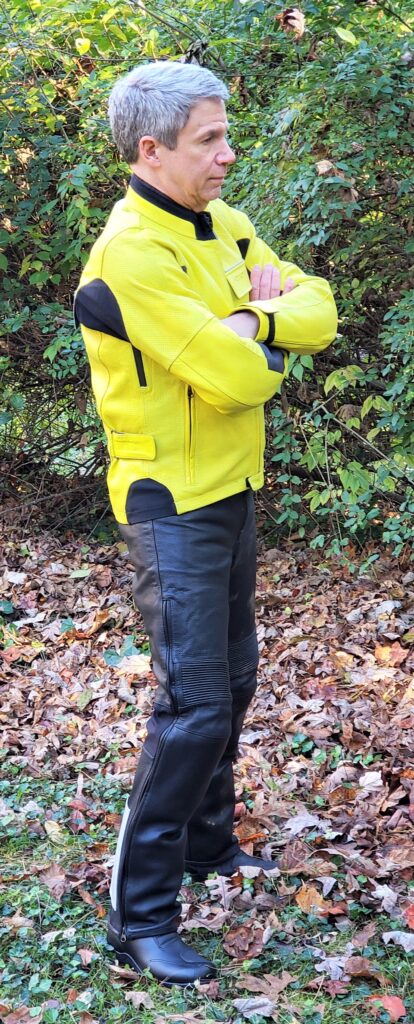 The leather component of Corium+ is itself a combination of bonded leather and natural latex, giving it the ability to stretch slightly and making it hydrophobic. Hence, even without the membrane, it’s more water-repellent than plain leather, so Corium+ garments don’t absorb water, grow soggy, and take on weight. That’s good, because the Transit suit is already somewhat hefty when compared to textile garments, with dry weights of 5.6 pounds for the jacket and 4.4 pounds for the pants. Since my suit is at the small end of the range, most will weigh even more. Again, this is not flimsy poseur-wear!
The leather component of Corium+ is itself a combination of bonded leather and natural latex, giving it the ability to stretch slightly and making it hydrophobic. Hence, even without the membrane, it’s more water-repellent than plain leather, so Corium+ garments don’t absorb water, grow soggy, and take on weight. That’s good, because the Transit suit is already somewhat hefty when compared to textile garments, with dry weights of 5.6 pounds for the jacket and 4.4 pounds for the pants. Since my suit is at the small end of the range, most will weigh even more. Again, this is not flimsy poseur-wear!
Another Corium+ advantage is the use of special dyes that reflect UV radiation, which Aerostich claims is good for an internal temperature as much as 15 degrees F lower than traditional black leather gear (presumably while wearing the all-black Transit 3 suit). Also, the micro-perforations purportedly add a slight cooling effect compared to unperforated leather, though less than perforated leather without a windproof backing; the perforations facilitate “exhaust,” but not “intake” airflow. A small percentage of the Transit 3 suit is comprised of elastane. Panels of this stretchy, lightweight, tough version of Spandex aid range of motion and reduce bulk in key areas, including the inboard sides of the upper arms, rear of the shoulders, behind the knees, and around the waistband of the pants; it also forms part of the collar, along with a smoother edge welt made of the lining material.
SIZING & FIT
Aerostich suits tend to be cut generously for the American physique and the Transit 3 is no exception. Whereas European gear is often tailored for trim frames and necessitates going up a size for our market, Aerostich seems to cater to the typical US buyer’s greater girth, or perhaps they just leave plenty of room for layering. In any case, even after carefully measuring myself and consulting the comprehensive sizing chart on Aerostich’s website, I wound up having to exchange my first suit—both jacket and pants—for smaller sizes. Since I value the ability to wear a full set of street clothes under my Roadcrafter II, extra room is welcome there, but the same arrangement just doesn’t feel right to me in leather. I expect leather gear to be more form-fitting, while still allowing good freedom of movement and a bit of layering inside the jacket, since leather isn’t highly effective insulation against cold. I strongly recommend a phone call to discuss sizing with Aerostich staff before you place your order. Custom tailoring, as offered on some other Aerostich gear, isn’t available for the Transit 3. Jacket sizes range from 38” to 52” at the chest, pants come in 30” to 44” waists, and all are available in short, regular, or long versions. Pants are only available in black, while the jacket can be ordered in black or—totally unique for a leather garment!—hi-viz yellow, like the one pictured.
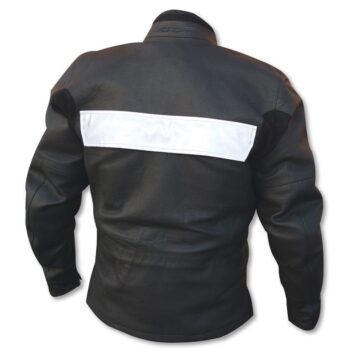 Once I had the correct size 38S (I’d started with a 40S, per the chart), I could appreciate how the jacket is cut to accommodate the riding position, with longish sleeves rotated forward and enough room across the upper back to avoid tightness while reaching for the handlebars, even in a moderate sport-touring crouch. Typical of Aerostich attention to detail, the tail extends lower than the front edge. Such riding-position-oriented tweaks aren’t extreme enough to make the jacket feel weird while standing, as can be the case with hardcore sport-riding gear. Nobody would mistake me for a bodybuilder, but I had to cinch down the waist adjustment straps to their limits to achieve enough taper to avoid excessive gapping at the jacket’s bottom edge. Apparently, Aerostich expects riders to have a larger waist-to-chest ratio, or at least near-equal measurements. The sleeves feel snug to me relative to the torso, limiting the amount of layering possible in a jacket that fits correctly in warm weather. A heated vest is no problem, but a thick sweater binds at the elbows. This would not have been the case with the larger jacket recommended by the sizing chart, but that garment felt cavernous over a T-shirt, with excessive sleeve length. Obviously, fit issues can be highly idiosyncratic due to riders’ unique dimensions and preferences; it’s best to discuss your order with Aerostich staff!
Once I had the correct size 38S (I’d started with a 40S, per the chart), I could appreciate how the jacket is cut to accommodate the riding position, with longish sleeves rotated forward and enough room across the upper back to avoid tightness while reaching for the handlebars, even in a moderate sport-touring crouch. Typical of Aerostich attention to detail, the tail extends lower than the front edge. Such riding-position-oriented tweaks aren’t extreme enough to make the jacket feel weird while standing, as can be the case with hardcore sport-riding gear. Nobody would mistake me for a bodybuilder, but I had to cinch down the waist adjustment straps to their limits to achieve enough taper to avoid excessive gapping at the jacket’s bottom edge. Apparently, Aerostich expects riders to have a larger waist-to-chest ratio, or at least near-equal measurements. The sleeves feel snug to me relative to the torso, limiting the amount of layering possible in a jacket that fits correctly in warm weather. A heated vest is no problem, but a thick sweater binds at the elbows. This would not have been the case with the larger jacket recommended by the sizing chart, but that garment felt cavernous over a T-shirt, with excessive sleeve length. Obviously, fit issues can be highly idiosyncratic due to riders’ unique dimensions and preferences; it’s best to discuss your order with Aerostich staff!
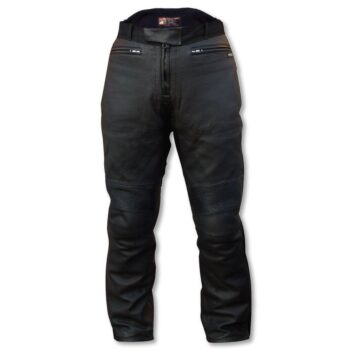 A note about those waist adjustment straps: When I pulled them tight enough to achieve the desired fit, quite a bit of excess length was left unsecured by their Velcro patches. I noted this when swapping to a smaller size and Aerostich generously accommodated me by shortening the straps on the replacement jacket to eliminate the problem. This modification may be available upon request on future orders, although pricing and availability have yet to be determined, and the overall strap design remains subject to further updating.
A note about those waist adjustment straps: When I pulled them tight enough to achieve the desired fit, quite a bit of excess length was left unsecured by their Velcro patches. I noted this when swapping to a smaller size and Aerostich generously accommodated me by shortening the straps on the replacement jacket to eliminate the problem. This modification may be available upon request on future orders, although pricing and availability have yet to be determined, and the overall strap design remains subject to further updating.
The jacket’s cuffs feature gusseted zippers and can be tightened with horizontal Velcro-equipped leather tabs. Relatively thin/short glove gauntlets will fit inside the unzipped cuffs (their gussets maintain weatherproofing), while more substantial gauntlets can be worn outside the zipped/cinched cuffs. The cuffs are—at least initially—rather stiff and bulky, due to their stout waterproof zippers and the doubled leather of the adjusting tabs, so optimizing the gauntlet-to-cuff interface may be challenging in some cases. Aerostich recommends initially “training” the cuffs to hug the wrists using a vice or clamp to deliberately crease the fold created by the tab closure at the desired setting to make wearing gauntlets outside the cuffs easier. Riders may also consider switching to a “Short” version to reduce sleeve length, assuming that doesn’t make the jacket’s hem sit too high at the waist. The unobtrusive collar is Mandarin-style, the front zipper has a flap behind it to further protect against wind and water entry, and zippered vents extend from each armpit halfway down the torso, with another across the upper back. A wide strip of reflective 3M Scotchlite forms a flap over the back vent, but it can be secured in a folded-up position with Velcro patches to enhance airflow with the vent open, a clever design.
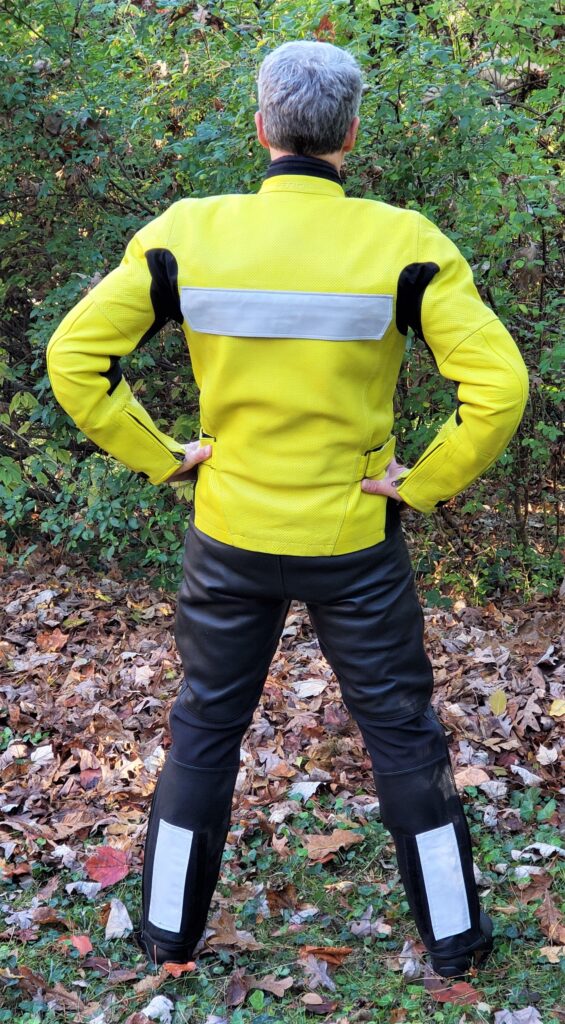 Obviously, any garment will fit everyone differently; I can only report on my experience. Nevertheless, my pants, which are labeled as having a 30” waist, objectively measure nearly 35” around their internal circumference. I normally wear 32” waist street pants and originally ordered Transit 3 pants in this size. Such street pants sit low on my hips, beneath the largest cross-section of my belly. The supposedly 30”-waist Transit 3 pants, which sit higher at my maximum girth, feel just right. That’s great, but their designation as 30” is mystifying—unless, perhaps, someone with a true 30” waist wore a pair of thick jeans underneath their Transits. Maybe this suit can be worn as an over-garment or a stand-alone garment, but not on the same person. My old Roadcrafter somehow manages to pull off that feat, but a bunch of excess textile (in stand-alone mode) is far easier to deal with than the same excess in leather. You may have to decide which way you’ll use your Transit 3 and choose a size accordingly.
Obviously, any garment will fit everyone differently; I can only report on my experience. Nevertheless, my pants, which are labeled as having a 30” waist, objectively measure nearly 35” around their internal circumference. I normally wear 32” waist street pants and originally ordered Transit 3 pants in this size. Such street pants sit low on my hips, beneath the largest cross-section of my belly. The supposedly 30”-waist Transit 3 pants, which sit higher at my maximum girth, feel just right. That’s great, but their designation as 30” is mystifying—unless, perhaps, someone with a true 30” waist wore a pair of thick jeans underneath their Transits. Maybe this suit can be worn as an over-garment or a stand-alone garment, but not on the same person. My old Roadcrafter somehow manages to pull off that feat, but a bunch of excess textile (in stand-alone mode) is far easier to deal with than the same excess in leather. You may have to decide which way you’ll use your Transit 3 and choose a size accordingly.
With the proper waist size, the pant legs are nicely snug on me, and would allow only a thin set of thermals underneath before feeling restrictive, despite Aerostich’s assurance they can be worn alone or as over-pants. Again, Aerostich may count on American riders having a larger waist-to-thigh-width ratio than my proportions, and I did switch to a smaller size than recommended by their standard chart. Pant leg length is perfect—long enough to fully cover boot shafts in the riding position without being too long (and bunching) while standing or walking; this dimension exactly matches the 30” (length) listed on the chart for my size.
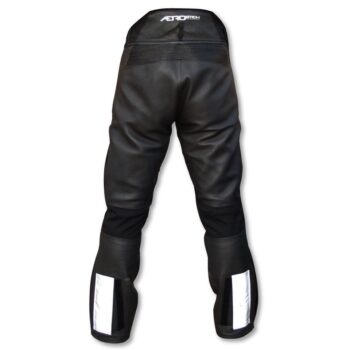 The pant legs feature extra-long zippers along their outboard seams, reaching mid-thigh and making ingress/egress easy, and they’re backed by flaps for more insurance against intrusion by the elements. Accordion panels above the knees increase flexibility there, and the fly is gusseted for extra protection against water entry (although this presents a bit of an impediment when “off-loading” liquid). The cuffs are large enough to enclose adventure or armored road racing boots and can be tightened around lower profile street boots using vertical hook-and-loop strips. These strips limit adjustment to two discreet positions; a larger, solid patch would have allowed more variation. Also, the leg cuffs may need the same “training” as the sleeve cuffs, as they put up a little resistance against snugging, at least when new. Wide patches of Scotchlite extend along the rear of the calves. The waist band is cut higher in the back to prevent gapping between jacket and pants in the riding position, even without use of the extra-long connecting zipper that starts/finishes above the front pants pockets. An accordion panel beneath the waist in the back ensures full range of motion while crouched with the pants and jacket zipped together. Aerostich sells an adapter “ellipse” ($37) for mating the Transit 3 jacket with Roadcrafter pants; this is necessary because they have zippers of differing lengths. Unusual for riding pants, belt loops are included on the Transit 3. Alas, these didn’t remedy the great size discrepancy of my original size 32” pants without copious unwelcome bunching.
The pant legs feature extra-long zippers along their outboard seams, reaching mid-thigh and making ingress/egress easy, and they’re backed by flaps for more insurance against intrusion by the elements. Accordion panels above the knees increase flexibility there, and the fly is gusseted for extra protection against water entry (although this presents a bit of an impediment when “off-loading” liquid). The cuffs are large enough to enclose adventure or armored road racing boots and can be tightened around lower profile street boots using vertical hook-and-loop strips. These strips limit adjustment to two discreet positions; a larger, solid patch would have allowed more variation. Also, the leg cuffs may need the same “training” as the sleeve cuffs, as they put up a little resistance against snugging, at least when new. Wide patches of Scotchlite extend along the rear of the calves. The waist band is cut higher in the back to prevent gapping between jacket and pants in the riding position, even without use of the extra-long connecting zipper that starts/finishes above the front pants pockets. An accordion panel beneath the waist in the back ensures full range of motion while crouched with the pants and jacket zipped together. Aerostich sells an adapter “ellipse” ($37) for mating the Transit 3 jacket with Roadcrafter pants; this is necessary because they have zippers of differing lengths. Unusual for riding pants, belt loops are included on the Transit 3. Alas, these didn’t remedy the great size discrepancy of my original size 32” pants without copious unwelcome bunching.
OTHER FEATURES
High-quality YKK waterproof zippers are used throughout the exterior of both jacket and pants, presumably sealing water out of all closures, pockets, and vents. Pockets are fewer and quite a bit smaller than those found on Roadcrafters and other Aerostich gear, but they’re still functional. Handwarmer pockets in the jacket and front pockets in the pants are lined with a soft fabric, shallow pockets on the right forearm and left chest are convenient for credit cards, IDs, keys, or folded bills, and two large interior pockets built into the jacket lining provide options for phone or wallet (which would also just barely fit in the handwarmer pockets).
Aerostich’s TF5 armor is made by German specialist manufacturer SAS-TEC and resides in lining pockets at the expected locations—knees, hips, shoulders, elbows, and back—with all but the hip pads carrying CE Level 2 ratings (the hips are Level 1). There are no provisions for adjusting the position of the armor, but I found all pieces fit fine, and only the elbows were a bit of a struggle to remove/replace. TF5 armor is visco-elastic, meaning it’s relatively soft and flexible until impact, when it instantaneously firms up to absorb shock energy rather than transmitting it to the body part beneath it. This process reverses when pressure is relieved, so the armor “resets” quickly to provide protection from successive blows.
As with all Aerostich gear, the Transit 3 carries a 30-day money-back return policy (in new condition) and a two-year guarantee against defects in materials or workmanship. Sizing issues notwithstanding, I’m thoroughly impressed with the Transit 3, even before riding the first mile in it. With sizing now sorted and hopes that some break-in will take care of my other initial concerns, I’m excited to begin the on-road assessments. When was the last time you looked forward to riding in the rain?
At $1,037 for the jacket and $927 for the pants (a $100 discount applies when buying both together), owning a Transit 3 involves considerable financial commitment. Given Aerostich’s history of producing extraordinary riding gear and the initial impression of superlative quality delivered by this suit, it seems likely real-world use will yield evidence such price tags are fully justified. Stay tuned to see if long-term testing supports the cost of ownership.


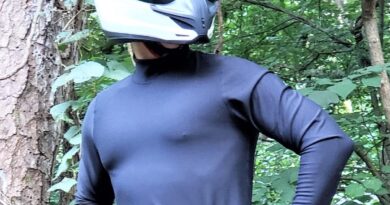

Thanks, Ray. Those boots are the Web GTX model from Alpinestars, my review of which you can find in the June ’22 issue of BMW Owner’s News. Let us know how how the Transit 3 works for you!
Very detailed review! Until reading it, I had all but given up on a full set of leathers–not so much for the price, but for fear of not finding a set that would fit my well over the hill physique. Assuming I can find the right combination of sizes (for the jacket and pants) I’d be more than willing to give leather a shot. By the way, the set looked smashing on you. Curious–what were the boots you wore in the photos?